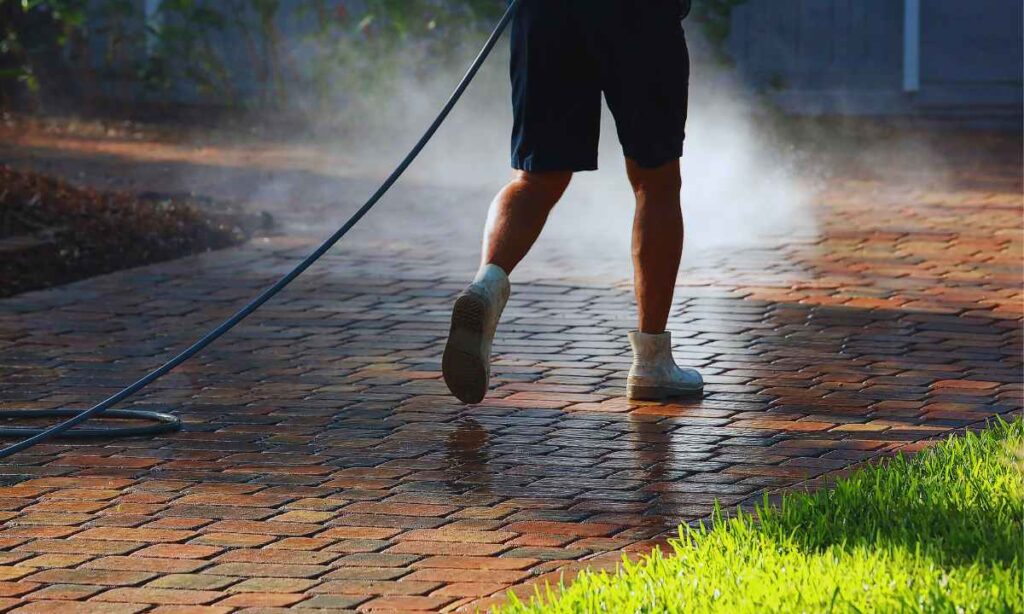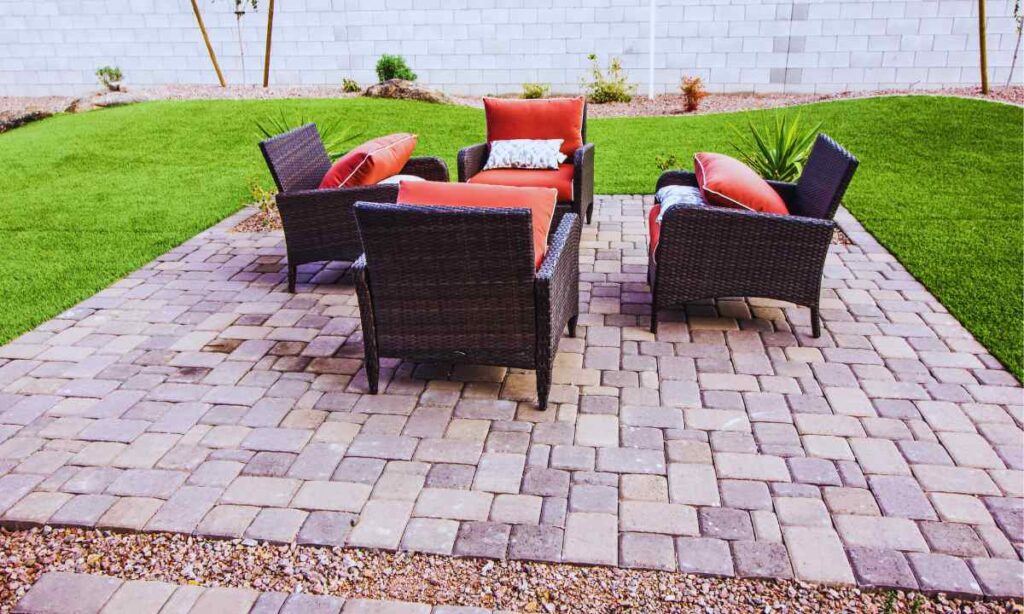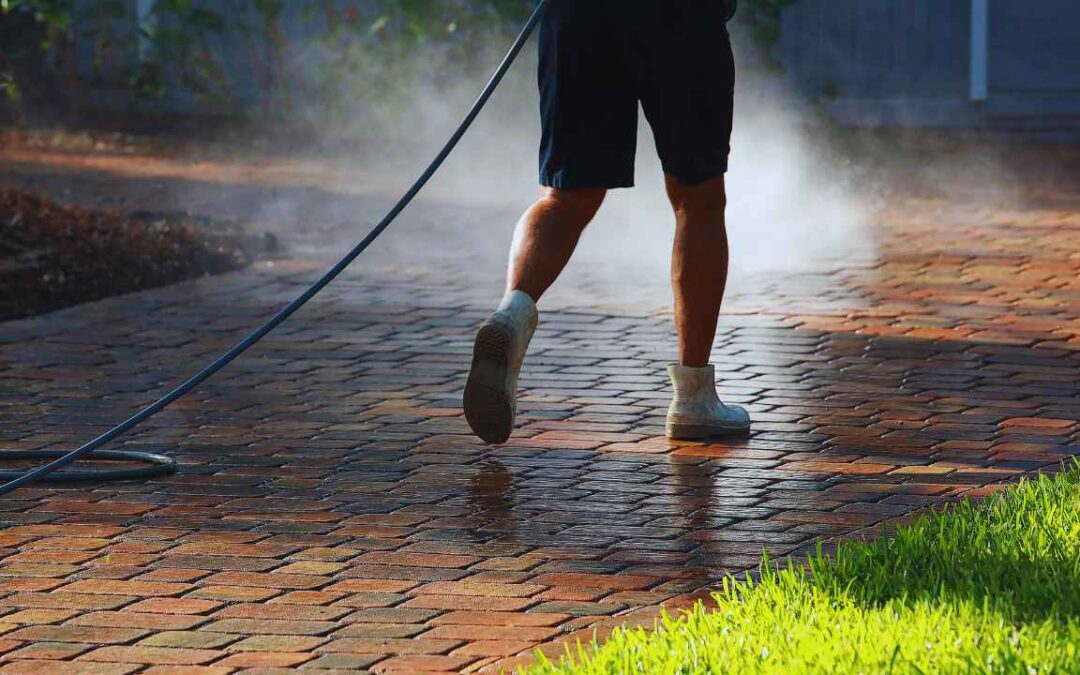Sealing Pavers for Long-Term Protection
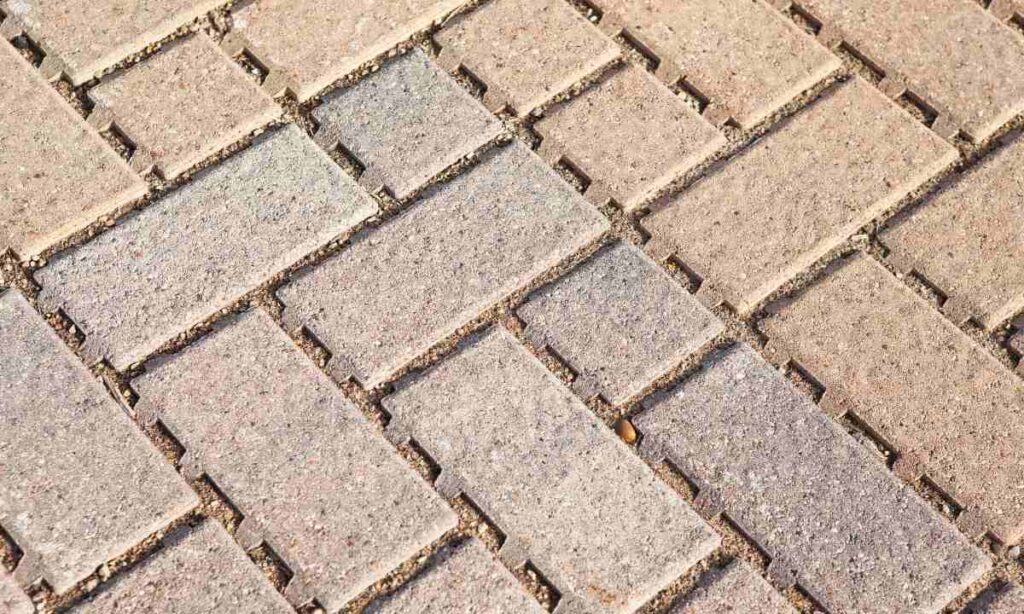
Sealing is the step that separates a short-lived patio from one that lasts for decades. In Missouri’s mix of humidity, heavy rain, and temperature swings, unsealed joints act like open doors for water and debris. Once moisture gets into the base, the freeze–thaw cycle expands it, loosening the pavers and weakening the foundation.
Do You Need to Seal Pavers in Missouri?
Yes — sealing is essential for Missouri’s climate. Rain and humidity accelerate the wear on unsealed surfaces, while repeated freezing and thawing cause pavers to shift or crack. A good sealer locks out moisture, protects against fading, and makes cleanup easier after storms or pollen season. Homeowners often wonder if sealing is worth the cost or how long it lasts. The truth is, when applied correctly, a high-quality sealer can extend the life of your pavers by years while preserving their color and texture.
Choosing the Right Paver Sealer
Not all sealers perform the same way. Penetrating sealers soak into the surface to create an invisible barrier against moisture without changing the appearance or texture ideal for patios and walkways that need traction. Film-forming sealers, on the other hand, sit on top of the surface and add a subtle sheen while providing stronger UV protection. They work well for driveways or decorative areas where you want a richer finish.
Always match the sealer to the material concrete, clay, or natural stone since each type absorbs and reacts differently. A sealer made for concrete pavers might darken or streak clay brick if applied incorrectly.
When and How Often to Reseal
Sealers don’t last forever. In Missouri’s weather, reapply every two to three years to keep the barrier intact. Before sealing, make sure the surface is completely dry at least forty-eight hours without rain or heavy dew. Applying sealer to damp pavers traps moisture inside, which can leave a cloudy white film once it dries.
A properly sealed surface resists stains, stays cleaner longer, and prevents joint sand from washing away during storms. Done right, sealing isn’t just maintenance it’s the single best way to protect your investment and keep your hardscape performing like new. Sealing also protects the paver’s concrete binder from salt and alkali attack. In Missouri winters, road salt runoff often reaches driveways, where it reacts with calcium hydroxide in the mix causing surface scaling and color loss. A breathable sealer blocks that reaction without trapping moisture.
Preventing Common Paver Problems
Even the best-built patio or driveway can show wear if small issues are ignored. Weeds, stains, and drainage problems don’t just hurt curb appeal they shorten the life of your pavers. The key is staying one step ahead with consistent upkeep and smart materials that match Missouri’s conditions.
How to Stop Weeds and Ants Between Pavers
Weeds and ants love loose joints. After every deep clean, apply polymeric sand between pavers and make sure it’s properly activated with a light mist of water. That sand hardens once dry, locking the joints and sealing out tiny gaps where roots and insects take hold.
For homeowners dealing with recurring ant problems, ant-repelling sand blends or additives can make a noticeable difference. They deter colonies from nesting beneath the surface without harming nearby plants or pets. If you ever see sand washing out after heavy rain, that’s your sign to reapply before it weakens the base.
Preventing Stains and Fading
Concrete and clay pavers are porous, which means they’ll soak up stains fast if left unprotected. Wipe spills within twenty-four hours to prevent oil, rust, or leaf residue from setting in. On south-facing patios where sun exposure is strongest, use a UV-stable sealer that resists fading and keeps colors rich through summer heat.
If your pavers start turning white, it’s usually not a sealer defect it’s trapped moisture or mineral buildup. Allowing the surface to dry fully before sealing and using breathable products keeps that from happening.
Managing Drainage and Erosion
Water control is one of the most overlooked parts of paver maintenance. A flat or uneven patio traps water, slowly eroding the sand and causing pavers to sink or heave. Maintain a slope of about one-eighth inch per foot away from the house or main structure to keep water moving.
If your yard collects runoff or sits on heavy clay, French drains or permeable paver bases can help redirect excess water. These systems improve surface permeability, strengthen the aggregate base, and stabilize the joints long-term. RWPS often recommends them for properties in lower-lying parts of the St. Louis area where soil saturation is common after storms. Field crews see most drainage-related settling on north-facing patios or shaded yards where soil stays damp. If the base never fully dries, freeze expansion doubles the upward pressure during winter. Installing a small French drain or weep channel near those low spots can solve years of frustration.
Pavers vs. Concrete: Which Is Easier to Maintain in Missouri?
Many Missouri homeowners start their projects thinking concrete is the “set it and forget it” option, while pavers demand constant upkeep. The truth sits somewhere in the middle. Both materials handle the St. Louis climate differently, and understanding those differences helps you choose what really fits your long-term goals.
Missouri’s freeze–thaw cycles and clay-heavy soils are rough on rigid slabs. When the ground shifts, concrete tends to crack. Pavers, being modular, flex with that movement. That flexibility is why maintenance looks different rather than harder. Pavers need regular cleaning and sealing, while concrete often needs patching or full resurfacing once cracks appear.
Quick Comparison: Pavers vs. Concrete in Missouri
| Feature |
Pavers |
Concrete |
| Initial Cost |
Higher upfront due to materials and installation |
Lower initial cost |
| Maintenance Frequency |
Clean and seal every 2–3 years |
Occasional crack repair or resurfacing |
| Repair Process |
Replace individual units easily |
Requires patching or full replacement |
| Durability in Clay Soil |
Flexible—adapts to shifting base |
Rigid—prone to cracking |
| Visual Longevity |
Colors can be refreshed with sealer |
Surface fades and stains over time |
| Lifespan (ICPI/ACI Data) |
25–50 years with care |
20–30 years depending on climate and cracks |
When homeowners ask, “Are concrete patios less maintenance than pavers?”, the honest answer is not really just different. Concrete may need fewer touch-ups, but once it cracks, there’s no quick fix. Pavers demand more routine care, but they reward you with flexibility, easier repairs, and a finish that can look new decades later with proper sealing. Homeowners choosing between the two should also think about long-term flexibility. When a concrete section cracks, repair means patching or replacing the whole slab. With pavers, individual units can be lifted, the base corrected, and pieces reset no demolition required. Over time, that serviceability keeps ownership costs lower.
For Missouri’s unpredictable soil and weather, most pros including the team at RWPS lean toward pavers for long-term resilience and aesthetics.
Seasonal Maintenance Checklist for St. Louis Homes
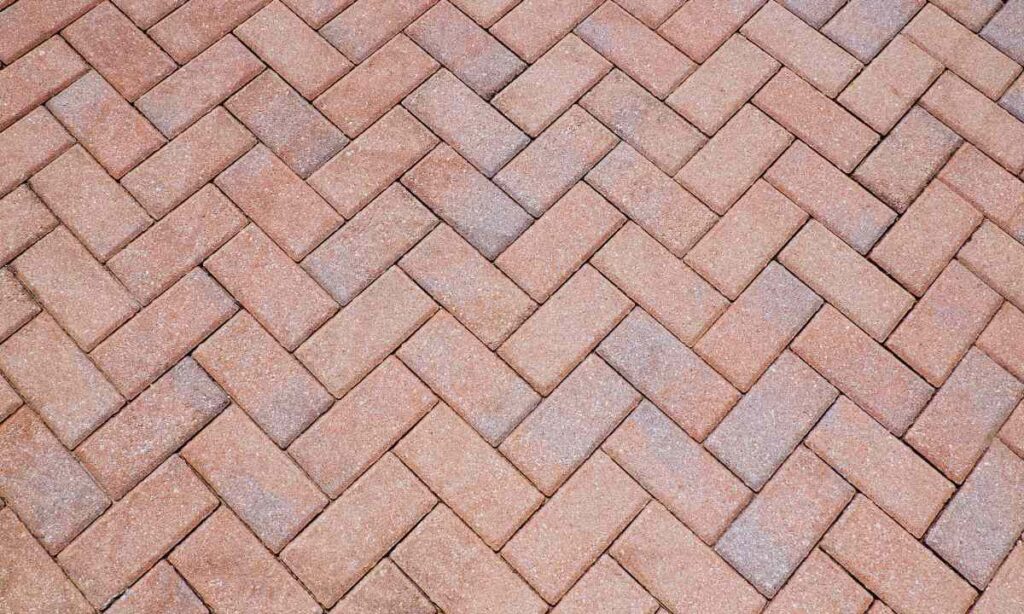
Paver care isn’t a one-time job it’s a year-round routine shaped by Missouri’s weather. Each season brings its own set of challenges, from spring rains that wash out joints to winter freezes that test the stability of the base. Following a simple seasonal checklist keeps patios, walkways, and driveways in top shape without major repairs. For quick reference, consider turning this checklist into a printed card or magnet. Many RWPS clients keep one near their garage sink as a seasonal reminder.
Spring
Spring is the time to reset your hardscape after winter’s freeze–thaw stress. Start with a deep clean using a low-pressure wash to remove grime and leftover de-icing residue. Once the surface is dry, inspect for any heaving or separation caused by expanding clay soil and frost. Finish by re-sanding the joints with polymeric sand to restore stability and block out early weed growth.
Summer
Warm, dry weather makes summer the ideal time to apply sealer. Low humidity allows proper curing and prevents haze or streaking. It’s also a good time to check irrigation systems—overspray from sprinklers can promote algae or moss growth in shaded areas. A quick rinse every few weeks helps keep the surface clear and reduces buildup from pollen and dust.
Fall
Leaves are your main concern in fall. Clear them frequently to avoid organic stains or tannin marks on the pavers. Before temperatures drop, fill small cracks or gaps to keep water from seeping into the base. This simple step prevents major damage when freezing temperatures return. Fall is also a smart time for one last light cleaning and inspection before sealing if it’s due.
Winter
When snow and ice hit, a few small habits make a big difference. Avoid salt-based de-icers—they break down paver surfaces and joint sand. Instead, use calcium magnesium acetate, which melts ice safely without harming the finish. Use a plastic shovel instead of metal to prevent scratches, and clear snow promptly to reduce freeze damage. Keeping the surface clean through winter pays off come spring when everything thaws evenly.
How Much Does Professional Paver Maintenance Cost in St. Louis?
Homeowners often ask what it really costs to keep their pavers looking and performing like new. In the St. Louis area, professional cleaning and sealing typically range from $1.50 to $3.00 per square foot, depending on several key factors: the type of sealer used, the total surface area, and how easy the space is to access. Tight patios or steep driveways may take longer to prep and finish, slightly raising the cost.
Professional sealing is worth the investment. When done correctly, it can increase the lifespan of your pavers by roughly 30 percent, keeping colors richer and joints tighter for years. Professionals use commercial-grade cleaners and sprayers that ensure even coverage, proper curing, and no trapped moisture. For most St. Louis homeowners, that means fewer repairs, no sealer haze, and long-term savings compared to DIY work that needs redoing every season.
If you’re deciding between doing it yourself or hiring out, the best approach is to consider longevity. A well-sealed surface resists freeze–thaw damage, oil stains, and erosion far better than one treated inconsistently. Over time, that difference more than pays for itself in reduced maintenance. According to the Interlocking Concrete Pavement Institute (ICPI), professional sealing done on schedule can cut surface deterioration by nearly one-third compared to unsealed installations. That makes it one of the highest-ROI maintenance steps for hardscapes in clay-soil regions like eastern Missouri.
When to Call a Professional Paver Contractor
Even with consistent upkeep, there are times when expert help is the smarter call. If you notice water pooling after rain, edges beginning to collapse, or widespread discoloration that cleaning doesn’t fix, those are clear signs the surface needs professional attention. These problems point to shifting in the base layer or drainage issues that require more than a surface treatment.
That’s where Retaining Wall & Paving Solutions stands apart. With a licensed engineer on staff and a 10-year warranty on all wall installations, the team doesn’t just clean or seal they diagnose the root causes behind surface wear and rebuild sections where necessary for long-term stability. If water consistently pools after light rain or you see sinking near downspouts, those are signs of base migration not just surface wear. RWPS inspects slope, drainage, and compaction depth before recommending repairs to ensure the fix lasts, not just looks good.
For homeowners planning larger projects or restorations, it’s worth exploring RWPS’s paver installation services in St. Louis or their patio construction options. Both offer the same engineered precision and craftsmanship that make maintenance easier down the road.
If your pavers are showing uneven wear or drainage issues, don’t wait until small fixes become rebuilds. RWPS provides professional assessments and maintenance solutions designed for Missouri’s soil and weather built to last and backed by expertise you can trust.
How to Keep Your Pavers Looking New for Decades
Keeping pavers in top condition isn’t complicated it just takes consistency. Think of it as a repeating cycle: clean, seal, and inspect. Each step builds on the other. Cleaning removes the grime that wears down the surface. Sealing locks out moisture and protects color. Inspection catches small issues early, before they spread into costly repairs.
Here’s a simple annual checklist St. Louis homeowners can follow:
-
Spring: Deep clean and re-sand joints after winter’s freeze–thaw stress.
-
Summer: Reseal surfaces while humidity is low and conditions are ideal for curing.
-
Fall: Clear leaves, check drainage, and fill small cracks before cold sets in.
-
Winter: Avoid salt-based de-icers and shovel gently to prevent surface damage.
Following that rhythm year after year keeps patios and driveways performing like new even in Missouri’s unpredictable weather.
If your pavers are showing early signs of wear or haven’t been sealed in several years, it’s the perfect time for a professional tune-up. Schedule a professional paver assessment and keep your outdoor spaces looking solid, safe, and beautiful for decades to come.
Questions St. Louis Homeowners Ask About Paver Care
Can I pressure-wash sealed pavers?
Yes, but only with care. Use a pressure washer set to 1,500 PSI or less and keep the nozzle at least twelve inches from the surface. Higher pressure can strip the sealer or blow out the joint sand. If your pavers are newly sealed, wait at least a week before washing to allow the sealer to cure fully.
How long should pavers dry before sealing?
At least forty-eight hours. Pavers must be completely dry both on the surface and within the joints before any sealer is applied. Trapped moisture is what causes that cloudy white haze many homeowners see afterward. For humid St. Louis weather, aim for two to three warm, dry days in a row.
Why do my pavers turn white after sealing?
That haze is caused by moisture trapped beneath the sealer. It happens when the surface isn’t fully dry or when too much sealer is applied. The fix usually involves gentle stripping and resealing once conditions improve. Choosing breathable, film-forming sealers also helps prevent this issue in Missouri’s humid climate.
How do I stop ants between pavers?
Re-sand the joints with polymeric sand and keep them compacted. This sand hardens when activated with water, blocking the gaps where ants and weeds nest. For recurring issues, use a sand blend with ant-repelling additives after your next deep clean.
What happens if I never reseal my pavers?
They’ll deteriorate faster and lose color. Without a protective seal, moisture seeps into the base, causing shifting during freeze–thaw cycles. Stains set in deeper, and the surface fades under UV exposure. Regular resealing every two to three years keeps the structure tight and the finish vibrant.
Quick Recap: Essential Paver Care Lessons for St. Louis Homeowners
-
Routine matters most. Stick to a clean–seal–inspect cycle to prevent shifting, staining, and moisture damage caused by St. Louis’s clay soil and freeze–thaw conditions.
-
Clean gently and often. Use low-pressure washing (≤1500 PSI) and pH-neutral cleaners every few months to protect surface integrity and joint stability.
-
Seal for longevity. Apply a breathable sealer every two to three years; it shields against rain, UV fading, and winter erosion while extending paver life by up to 30%.
-
Mind the seasons. Spring and fall are inspection seasons; summer is ideal for sealing; winter requires salt-free de-icing and light snow removal.
-
Call pros when issues spread. Pooling water, edge collapse, or cloudy sealer haze signal deeper base or drainage problems best handled by RWPS’s experienced team.
-
Local insight counts. Missouri’s climate demands materials and methods designed for movement—regular maintenance keeps your patio or driveway ready for every season.
What to Do Next: Keeping Your St. Louis Pavers in Top Shape
By now, you’ve seen how much difference a steady maintenance routine can make. Pavers aren’t high-maintenance. Take care of them, and they’ll hold their color, stay level, and outlast most concrete slabs by decades.
Here’s the takeaway: keep to the clean seal inspect rhythm. Clean away dirt and buildup before it settles in. Reseal every couple of years to block out moisture. Inspect after every season change for small issues like joint washout or early signs of movement. These small habits keep patios, driveways, and walkways looking sharp through the city’s heat, humidity, and freeze–thaw cycles.
If you’re unsure where your surface stands, it’s worth getting a professional eye on it. Schedule a professional paver assessment with Retaining Wall & Paving Solutions. The RWPS team has a licensed engineer on staff, a decade-long warranty on wall installations, and the local experience to keep your outdoor spaces solid and beautiful for years to come.
Your pavers are built to last regular care just helps them prove it.
Further Reading & Verified Standards for Paver Maintenance
Interlocking Concrete Pavement Institute (ICPI) – Residential Concrete Paver Maintenance Guide
ASTM C140 – Standard Test Methods for Sampling and Testing Concrete Masonry Units and Related Units
Belgard Pavers – Maintenance & Cleaning Guide
https://dnr.mo.gov/water/what-were-doing/water-resources-center/stormwater-management
